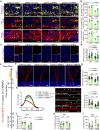Cell type-specific NRBF2 orchestrates autophagic flux and adult hippocampal neurogenesis in chronic stress-induced depression
- PMID: 37644025
- PMCID: PMC10465581
- DOI: 10.1038/s41421-023-00583-7
Cell type-specific NRBF2 orchestrates autophagic flux and adult hippocampal neurogenesis in chronic stress-induced depression
Abstract
Dysfunctional autophagy and impairment of adult hippocampal neurogenesis (AHN) each contribute to the pathogenesis of major depressive disorder (MDD). However, whether dysfunctional autophagy is linked to aberrant AHN underlying MDD remains unclear. Here we demonstrate that the expression of nuclear receptor binding factor 2 (NRBF2), a component of autophagy-associated PIK3C3/VPS34-containing phosphatidylinositol 3-kinase complex, is attenuated in the dentate gyrus (DG) under chronic stress. NRBF2 deficiency inhibits the activity of the VPS34 complex and impairs autophagic flux in adult neural stem cells (aNSCs). Moreover, loss of NRBF2 disrupts the neurogenesis-related protein network and causes exhaustion of aNSC pool, leading to the depression-like phenotype. Strikingly, overexpressing NRBF2 in aNSCs of the DG is sufficient to rescue impaired AHN and depression-like phenotype of mice. Our findings reveal a significant role of NRBF2-dependent autophagy in preventing chronic stress-induced AHN impairment and suggest the therapeutic potential of targeting NRBF2 in MDD treatment.
© 2023. Center for Excellence in Molecular Cell Science, CAS.
Conflict of interest statement
The authors declare no competing interests.
Figures








Similar articles
-
Nrbf2 protein suppresses autophagy by modulating Atg14L protein-containing Beclin 1-Vps34 complex architecture and reducing intracellular phosphatidylinositol-3 phosphate levels.J Biol Chem. 2014 Sep 19;289(38):26021-26037. doi: 10.1074/jbc.M114.561134. Epub 2014 Aug 1. J Biol Chem. 2014. PMID: 25086043 Free PMC article.
-
Hyperactive neuronal autophagy depletes BDNF and impairs adult hippocampal neurogenesis in a corticosterone-induced mouse model of depression.Theranostics. 2023 Jan 22;13(3):1059-1075. doi: 10.7150/thno.81067. eCollection 2023. Theranostics. 2023. PMID: 36793868 Free PMC article.
-
NRBF2 plays a crucial role in the acquisition process of learning and memory, independent of the Vps34 complex.Front Behav Neurosci. 2025 Feb 12;19:1529522. doi: 10.3389/fnbeh.2025.1529522. eCollection 2025. Front Behav Neurosci. 2025. PMID: 40013119 Free PMC article.
-
How autophagy controls the intestinal epithelial barrier.Autophagy. 2022 Jan;18(1):86-103. doi: 10.1080/15548627.2021.1909406. Epub 2021 Apr 27. Autophagy. 2022. PMID: 33906557 Free PMC article. Review.
-
Targeting impaired adult hippocampal neurogenesis in ageing by leveraging intrinsic mechanisms regulating Neural Stem Cell activity.Ageing Res Rev. 2021 Nov;71:101447. doi: 10.1016/j.arr.2021.101447. Epub 2021 Aug 14. Ageing Res Rev. 2021. PMID: 34403830 Review.
Cited by
-
Stress dynamically modulates neuronal autophagy to gate depression onset.Nature. 2025 May;641(8062):427-437. doi: 10.1038/s41586-025-08807-4. Epub 2025 Apr 9. Nature. 2025. PMID: 40205038 Free PMC article.
-
Costunolide normalizes neuroinflammation and improves neurogenesis deficits in a mouse model of depression through inhibiting microglial Akt/mTOR/NF-κB pathway.Acta Pharmacol Sin. 2025 Jul;46(7):1864-1876. doi: 10.1038/s41401-025-01506-w. Epub 2025 Feb 26. Acta Pharmacol Sin. 2025. PMID: 40011631 Free PMC article.
-
A depression-associated protein FKBP5 functions in autophagy initiation through scaffolding the VPS34 complex.Mol Neurobiol. 2025 Aug;62(8):9916-9934. doi: 10.1007/s12035-025-04897-3. Epub 2025 Apr 2. Mol Neurobiol. 2025. PMID: 40175715
-
Autophagy-Unlocking New Dimensions in the Pathology and Treatment of Depression.Cells. 2025 May 28;14(11):795. doi: 10.3390/cells14110795. Cells. 2025. PMID: 40497971 Free PMC article. Review.
-
Overexpression of autophagy enhancer PACER/RUBCNL in neurons accelerates disease in the SOD1G93A ALS mouse model.Biol Res. 2024 Nov 17;57(1):86. doi: 10.1186/s40659-024-00567-1. Biol Res. 2024. PMID: 39551782 Free PMC article.
References
-
- GBD 2017 Disease and Injury Incidence and Prevalence Collaborators Global, regional, and national incidence, prevalence, and years lived with disability for 354 diseases and injuries for 195 countries and territories, 1990-2017: a systematic analysis for the Global Burden of Disease Study 2017. Lancet. 2018;392:1789–1858. - PMC - PubMed
-
- Lucassen PJ, Stumpel MW, Wang Q, Aronica E. Decreased numbers of progenitor cells but no response to antidepressant drugs in the hippocampus of elderly depressed patients. Neuropharmacology. 2010;58:940–949. - PubMed
Grants and funding
LinkOut - more resources
Full Text Sources
Molecular Biology Databases

